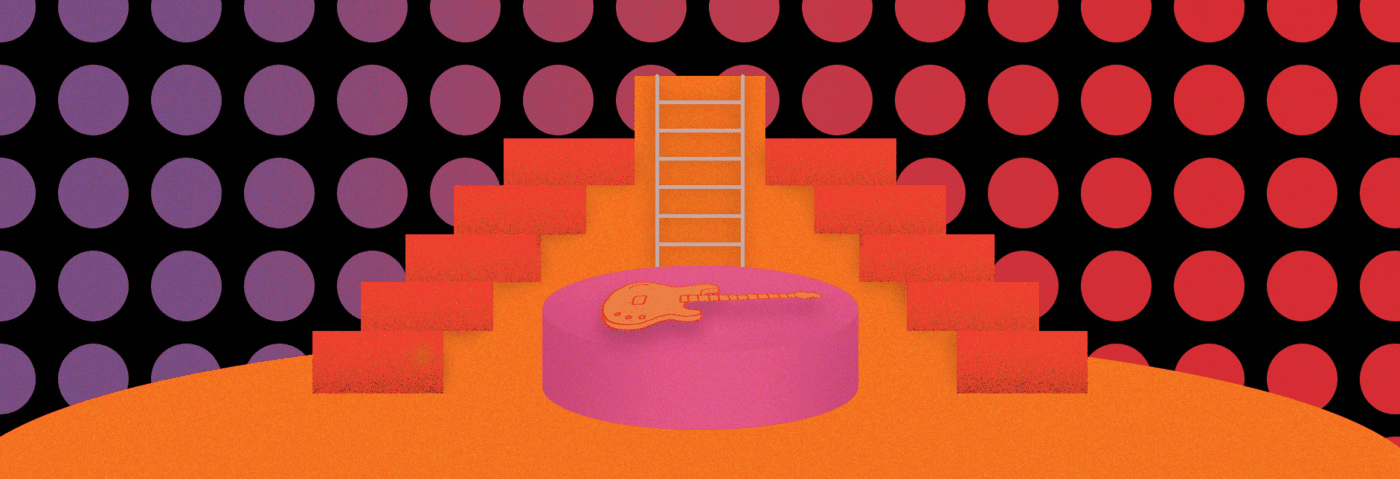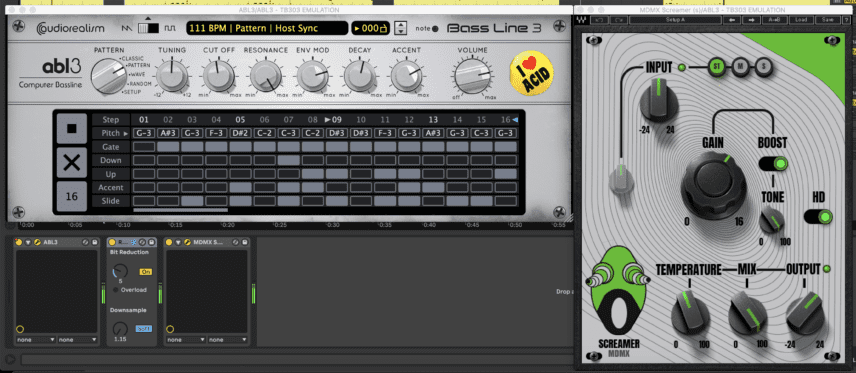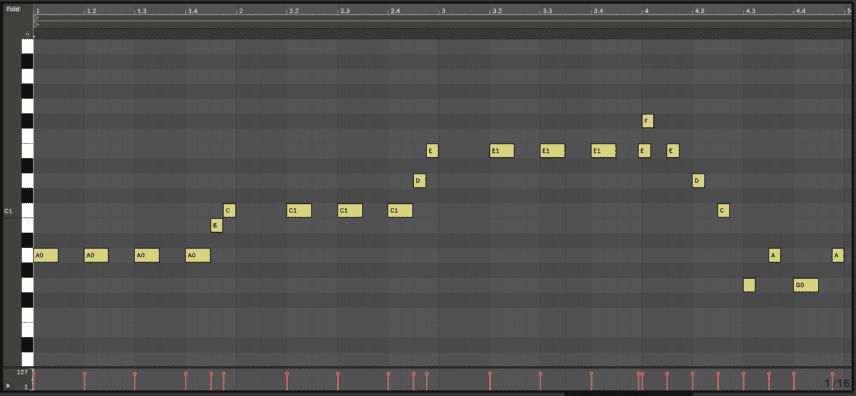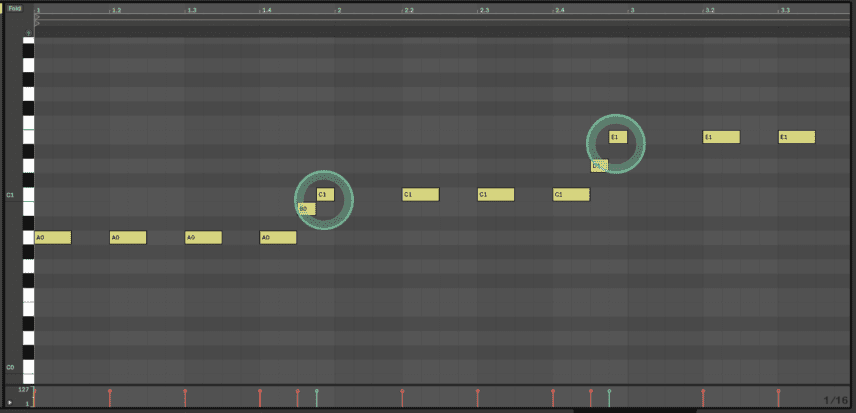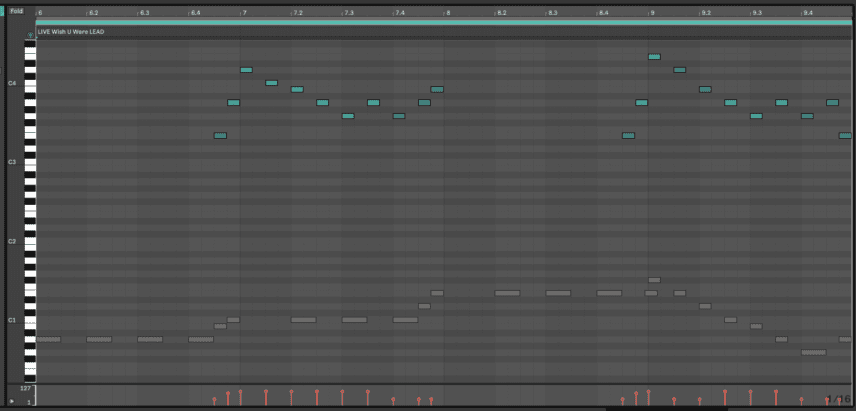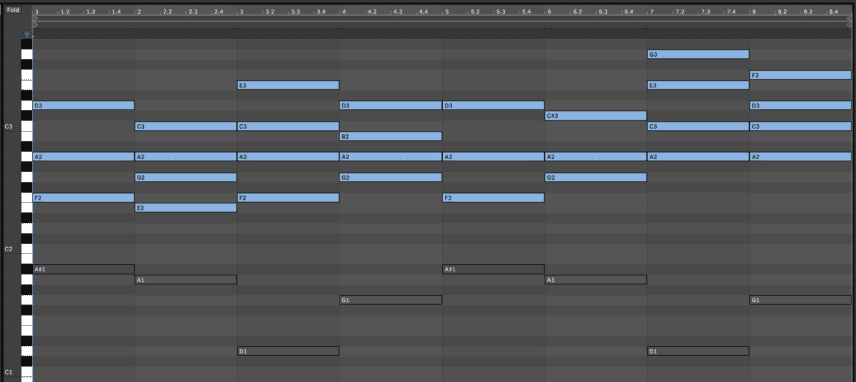In part one of this new two-part Passing Notes series, we break down the French duo’s bassline composition techniques to draw lessons from some of their greatest hits.
Daft Punk’s music covers a lot of genres, including some that they’ve arguably created by themselves. Despite all of the experimentation one thing that remains consistent throughout all of their productions is attention to detail. This is no different when it comes to their basslines.
After some analysis of their most famous riffs, we discovered tricks that they apply regularly in their tracks featuring busier bass parts. We also took notice of a fair amount of chord and arrangement techniques that they use to cater to the basslines.
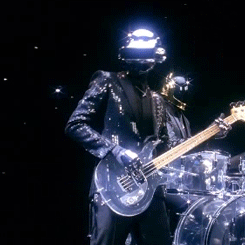
In this article, we note these Daft Punk go-to techniques for bass composition by breaking down the chord progressions, basslines and lead parts from three of their most iconic tunes: ‘Da Funk’, ‘Around the World’ and ‘Something About Us’.
To do this, we took a four or eight-bar loop from each track and recreated the bass and other instrument parts in Ableton. To follow along, download the session:
Da Funk
‘Da Funk’ was Daft Punk’s first hit, released as a single in 1995 and then included in their iconic 1997 debut album Homework. It is without a doubt one of the classics of ’90s house music despite being at a lower BPM of 111. The track’s one-note bass line is a masterclass in minimalism while the contrasting distorted TB-303 riff that comes in for the second half of the track is one of the most famous 303 riffs of all time.
The song’s key is G minor and the bass is playing a low G note with every kick, almost turning the line into a kick layer. This works in the arrangement’s context because the lead riffs on top provide patterns that are similar to more conventional active basslines.
The TB-303 riff that comes in at 2:26 also lacks low end so it cannot exactly be classified as a bassline but we want to take a look at it nonetheless.
Here’s a bounce of our recreation of four bars from ‘Da Funk’, first with the drums and stab and then with the bass parts in solo:
The 303 sequence contains the root note G, the minor 3rd A#, the minor 7th F, the perfect 4th C and the minor 6th D#. The perfect 5th D and the scale’s second note A are omitted.
The riff’s character is all about the Roland TB-303, and all of its features – including Gate, Down, Up, Accent and Slide – are used here. We used Audiorealism’s Bass Line 3 plug-in in our attempt to recreate it followed by Live’s Redux bit crusher and Waves’ MDMX Screamer to get that distorted timbre.
One other aspect of this line that stands out is the fact that the only muted note is the first 16th-note and it creates a very effective rest, providing just enough of a breather for the listener every time it loops.
Bass Composition Ideas from Da Funk:
- There’s nothing wrong with very minimal bass lines as long as the lead parts can make up for it with more melodic patterns.
- Sometimes when you think you have written a good busy bassline, try using it as a lead riff instead and program a simpler bass line that mainly focuses on complementing the kick, even as a layer.
- When sequencing basslines, (1) try omitting two or more notes from the scale so that the riff focuses on specific notes, and (2) try muting just one of the sixteen notes to get a small rhythmic rest in the riff.
We also have a full arrangement analysis of ‘Da Funk‘ in our Deconstructed series.
Around The World
‘Around The World’ was one of the singles from Homework, released the same year as the album in 1997, and it gained worldwide success as an instant club hit. A true homage to the French duo’s unspoken motto of less is more, the track only consists of five elements and the bassline plays a key role in the groove.
Speaking about the production process of this song Daft Punk have said it “was like making a Chic record with a talk box and just playing the bass on the synthesizer”.
The Chic-style disco influence is massive here and the bassline is a clear reference to ‘Good Times‘ by Chic, released eighteen years before Homework. This is evident in the bassline which starts off by emphasizing quarter notes, hitting with the kick. You might also remember this style of bassline from Queen’s ‘Another One Bites the Dust’ from 1980.
The track is in the key of E minor but the bass uses the A dorian scale, which is a mode of E minor so the notes are all the same.
Here’s our recreation of two sections from the track with both sections repeating twice:
The first progression goes A minor > C major > E minor > D major. The last chord is a bit more ambiguous because the bass fill on the fourth bar of each repetition does not emphasize the D note at all as it moves down the notes of the scale.
This chord pattern is very common in popular music and Daft Punk cleverly used it again sixteen years later in ‘Get Lucky’.
Back to the bassline, there are two signature Daft Punk tricks here that we will encounter again and again while looking at their bass production techniques.
The first is that, apart from the first chord, all of the chords come in on the 16th note before the downbeat. This creates a rhythmic push that adds swing due to the repeating emphasis of offbeat notes.
The second is the use of a rhythmic lead part that works seamlessly with the bassline. The one in ‘Around The World’ just wouldn’t be as hypnotic without that funky lead synth and the reason for this is when its notes occur. It sometimes plays at the same time as the bass, catching the same rhythm, and at other times it fills in small gaps between the bass notes to add syncopation, as you can see from the below screenshot of the bass MIDI below and the lead MIDI above.
The way the synth creates anticipation at the end of the third bar with two notes before the bass comes in for the fill in the fourth bar is especially worth noting, as well as the fact that all of the synth’s notes in the fourth bar are rhythmically matched by the descending bass fill.
There is one more bassline in this track in the chorus section and it sees the chord progression change to E minor > E minor > C major > B minor.
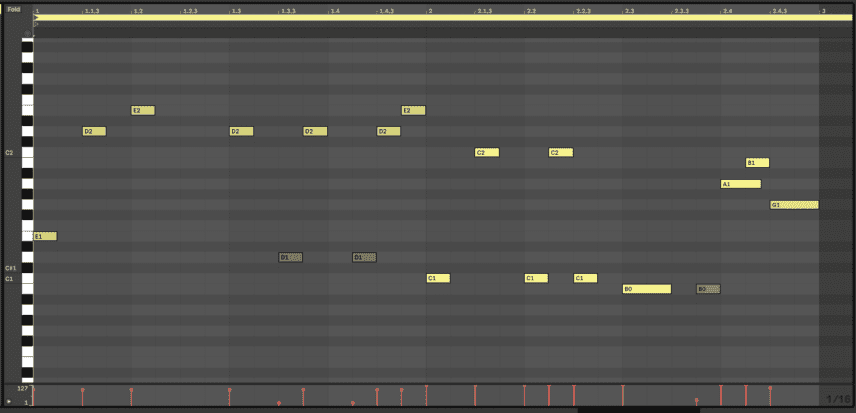
The genius here is that even though the bassline and the overall loop length changes (from four bars to two bars), the lead synth continues to play exactly the same as before. Despite this, it works perfectly because each lead note is still catching almost every bass note. This is no coincidence!
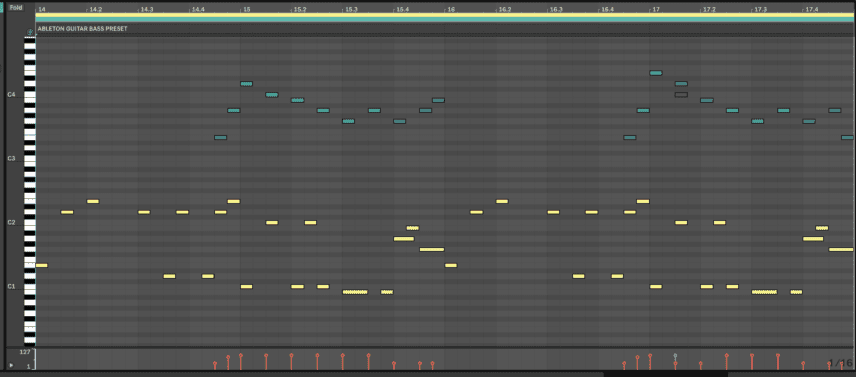
This second bassline also has three more classic Daft Punk bass tricks. The first is the use of the minor 7th note and octave. The first half of the loop has only these notes (E and D). The second is bass slides where notes glide into each other. This occurs at the end of the second bar of the loop with A sliding into B before hitting the last note G. This is much easier to recreate with an actual bass but glide functions on synths definitely work great as well. We used Ableton’s Guitar Bass preset that has pre-programmed glide that kicks in when the notes overlap in the piano roll.
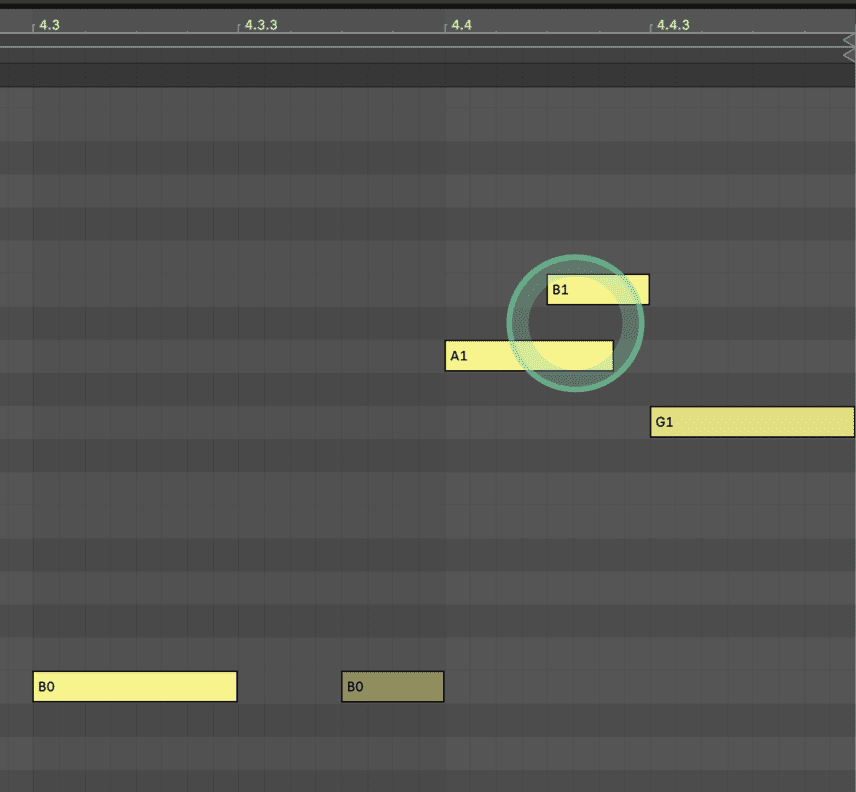
The third trick is dead notes. These are notes that you feel instead of hear because they come from a bass player plucking at a string without actually holding down a note. The best bass players (and programmers!) in the world hold this position because they know how to use dead notes to add levels of percussion to their lines, filling in spaces between the bass notes.
Here we’ve recreated rhythmic dead notes by programming notes playing at a much lower velocity than the others. The browned-out notes in the MIDI screenshot are the ones we are referring to.

Bass Composition Ideas from ‘Around The World’:
- A simple beat, a bassline and a lead that is designed to work perfectly with it are enough elements to carry a track.
- Try writing a chord progression where the chord changes occur every 16th-note before the downbeat.
- Use bass synths with some glide so that you can program bass slide fills.
- Try writing a lead melody and then two different basslines that work with it, as with the two basslines that both function under the same repeating synth melody in ‘Around The World’.
Something About Us
To many, ‘Something About Us’ from the 2001 album Discovery is the definitive Daft Punk ballad. The emotional talk box lyrics accompanied by a slick Rhodes chord progression and octave-hopping bassline again draw attention to making the most out of just a few quality parts.
The chord progression is a more unconventional eight-bar pattern that goes:
Bb major 7 > A minor 7 > D minor 7 (add9) > G major (add9)
Bb major 7 > A major 7 > A minor7/D > F major 13/G
The movement between different keys, the clustered voicings of the chords and the evolving nature of the progression are derived from jazz chord changes.
Here is the section of this track that we recreated in Ableton:
One of the most definitive qualities of this chord progression is that the Rhodes chords avoid playing the low root note and leave it to the bass, which only plays the root notes with octaves. The screenshot below shows the Rhodes MIDI with the lower root notes greyed out.
The concept is similar to orchestral composition where, when the whole orchestra is playing a chord, the bass and cello play some of the lower notes while the violins, brass and other sections divide up the higher notes.
Try activating the low root notes in the Rhodes channel in the project file we’ve provided and you’ll notice how much worse the Rhodes sounds with those notes included. It’s mind-blowing!
Back to the bassline, in the four-bar loop, the notes are hitting at the same time as the kick, forming a clear relationship between the bass and kick, with the bass regularly throwing in an octave to fill in the space between kicks.
Another clever trick the bass is implementing is slightly changing around the pattern on the third bar. In the first, second and fourth bars, the third note hits on the seventh 16th-note but in the next two bars, it hits on the eighth 16th-note.
Just like in ‘Around The World’, Daft Punk have again played in a lead part that works in perfect harmony with the bass. This is the muted guitar and in the below screenshot we’ve overlaid its MIDI with that of the bass.
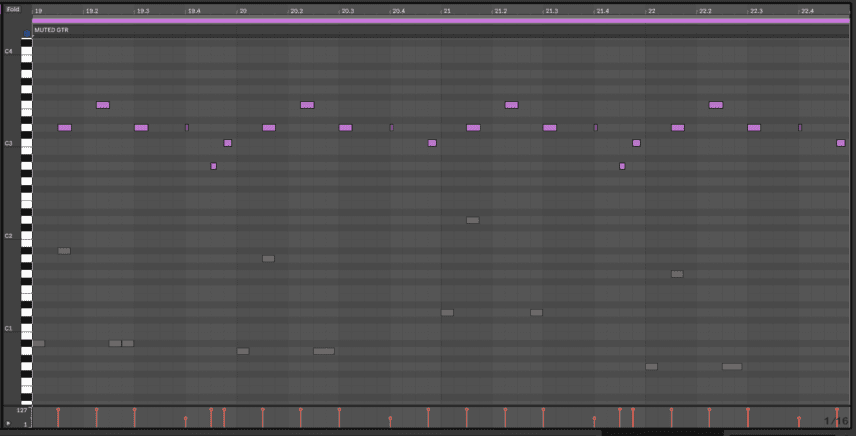
The movement in the first bar alone says it all, as the guitar’s second and third notes come right before and after the bass’ double hit. The other notes occupy the second half of the bar with a fill that leads perfectly into the bass coming back on the next downbeat.
This may look like very simple stuff as it’s just drawing 16th-notes around a piano roll but make no mistake, the human ear latches on to these simple groove tricks even without realizing it.
Bass Composition Ideas from ‘Something About Us’:
- Write chord changes where the instruments playing the chords omit the root note and leave it to the bass.
- Experiment with less busy basslines that mainly double up the kick. Use other elements to form a call and response relationship with the bass to fill in the spaces.
In the next part, we’ll focus on one more bassline from Discovery and two from 2013’s Random Access Memories. Stay tuned.
*Attack Magazine is supported by its audience. When you purchase through links on our site, we may earn an affiliate commission. Learn more.
